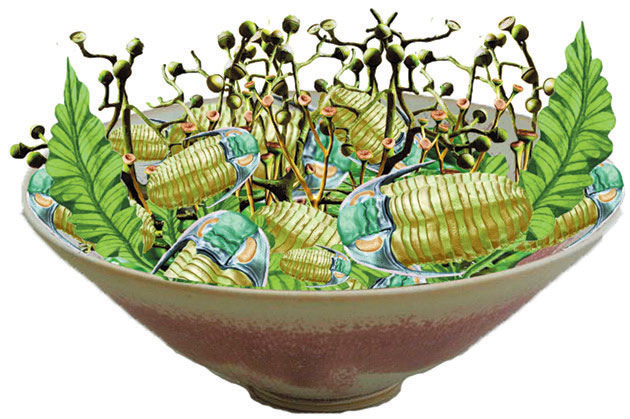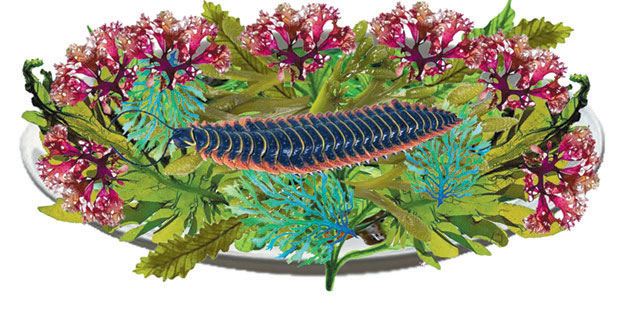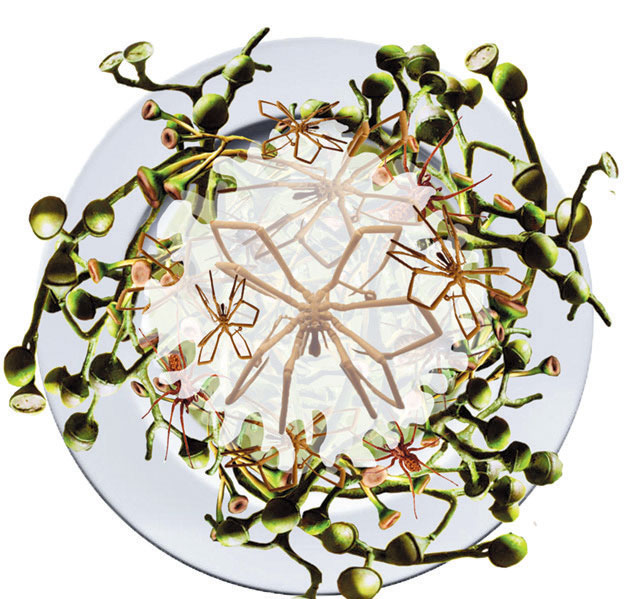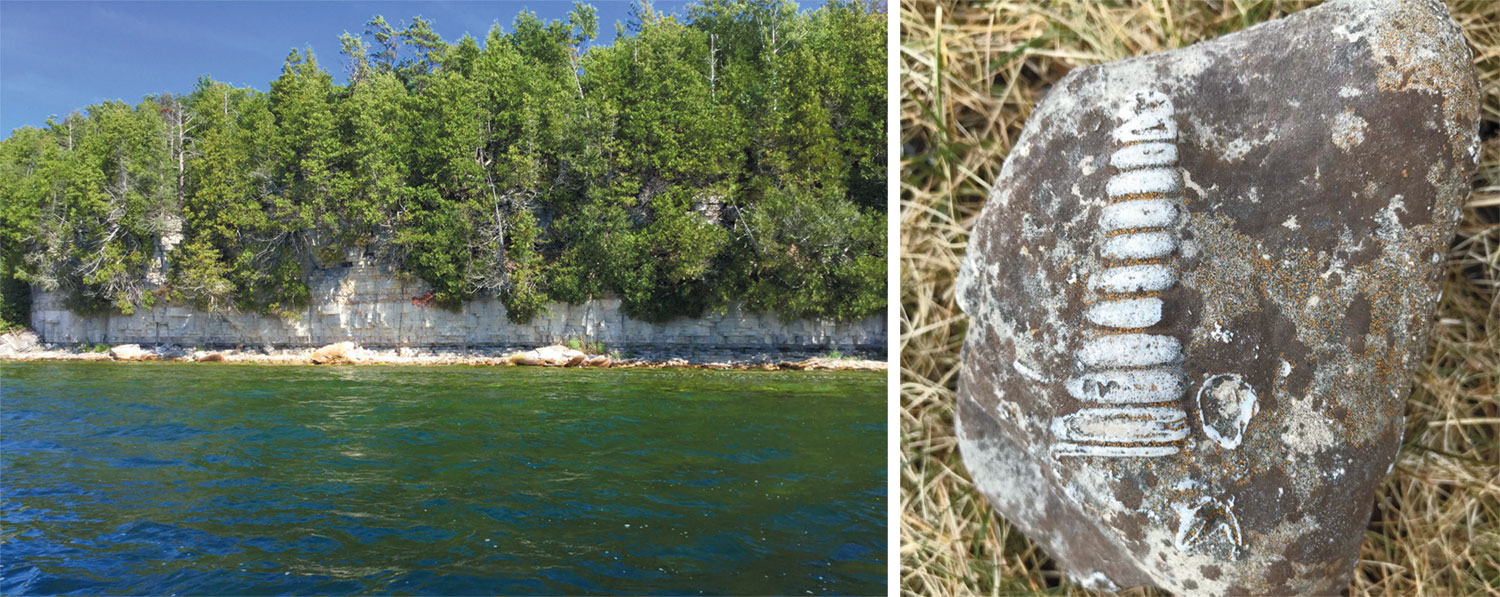Sustaining the Escarpment and the Lakes
THE DOCTOR HOPES TO HELP CURE WHAT AILS THEM
Roger Kuhns is an author, filmmaker, naturalist, teacher and a self-described “sustainologist.” He can sing you a tune or recite some verse. Most important he’s a geologist with a string of degrees; the most significant of which is a doctorate in economic geology. Few people know as much about the Niagara Escarpment, the Great Lakes and their infl uence on our climate, food and our way of life than does Kuhns.
He has some politician in him, too, having served on the Door County Board of Supervisors, a stint that is helping him with his current efforts to affect legislation at the national level to address climate change. As you can tell, he’s a man of many hats, and that may explain why you often see him wearing one.
He has spent the past few months touring the region to introduce his film “ESCARPMENT,” an award-winning documentary that delves into the formation of this remarkable geologic spine. The Niagara Escarpment is known for its cliffs and breathtaking vistas, stretching from Illinois eastward before producing its most climactic feature – Niagara Falls. In between it defines Wisconsin’s Door Peninsula, forms the southern boundary of Michigan’s Upper Peninsula, and reaches into Canada.
The documentary lays the groundwork for the Escarpment’s creation and the latest dynamic forces that have spectacularly produced the Great Lakes. In short, Kuhns says the movie helps to inform, enlighten and guide us towards being better stewards of the land and it takes a glimpse of what a sustainable future might look like.

Dr. Roger Kuhns
A Sustainable Future
Wearing all those hats, Kuhns is a well-known figure on the Door Peninsula and is now becoming known in the halls of Congress as he has taken a leadership role in the climate change debate. He currently resides in Mystic, Connecticut.
“Interestingly, I got into sustainability before there was a bandwagon. In the 1990s I had been working overseas in places like Africa, Russia and China and saw many mines being depleted, many communities in distress due to a lack of food, water and resources,” he explained. “Sustainability, which involves protecting our environment, enriching our communities and doing so in an economically responsible way, was badly needed. Returning to the U.S. led me to teaching and consulting on sustainability.”
Kuhns published a workbook called Sustainable Urban Agriculture that he describes as a do-it-yourself guide for those who want to grow their own food. “You see, I’m a geologist and I have a granite thumb, not a green thumb, so I figured if I could grow all this food, well, anyone could.”
After being approached by some citizens of Sturgeon Bay to write something that would help move the city towards sustainability, he penned a performance monologue titled “A View from the Bridge.”
“I posed the question: Could we actually sustain ourselves in this small city of 9,500 people? What if we had to source all our food and electricity in or near Sturgeon Bay? Could we do it?” he asked himself.
“I looked at all the vegetables, fruit, meat and dairy Sturgeon Bay’s 9,500 people consume every year. That’s about 6.5 million pounds of food, and more than half of that is vegetables,” said Kuhns, breaking it down to 55 percent vegetables, 27 percent fruit, 13 percent dairy and 7 percent meat.
“To grow and raise all that food, we need about 5,307 acres or 8.3 square miles,” he went on. “Realistically this would require wonderful cooperation with our area farmers and investment in winterized greenhouses and exclusive use of renewable energy. So, with optimal use of this space, we can grow all of Sturgeon Bay’s food and provide a couple thousand jobs.”
While preliminary, Kuhns says he’s working on a detailed business plan.
On the legislative front, Kuhns recently teamed with a colleague to write a book titled “Navigating the Energy Maze” that he says looks at the eight necessary bills we need to move from a carbon economy to a renewable energy economy.
“We plan to carry that to every office of Congress and work with them across the aisle to move toward this,” he said.
Kuhns is also working as a volunteer lobbyist with the nonprofit Citizens’ Climate Lobby (citizensclimatelobby.org).
“There are 90,000 of us across America, and I am the Connecticut state coordinator and help with eight chapters and hundreds of volunteers,” he explains. “We are petitioning Congress to pass a Carbon Fee and Dividend bill. That means we would put a price on carbon at the mine, the well and first port of entry for all fossil fuels. All the money, after administrative costs, would be sent back to every household in America to help cover the cost of moving from a fossil-fuel based energy system to a renewable energy system.”

“The escarpment is something like
our canary in a coal mine. We can tell
how things are going by the health of its
ecosystems (and it is currently stressed).”
- Dr. Roger Kuhns
Escarpment’s Migration
Clearly, sustainability is at the heart of his documentary, and one of the most entertaining parts of the film delves into the creation of the Niagara Escarpment and life’s ability to withstand catastrophic events over the past hundreds of millions of years. It takes the audience back to a time when today’s Great Lakes basin was a warm salty sea situated 16 degrees south of the equator. Kuhns goes on to describe the climate as what you might expect – hot and humid.
Creation of today’s Niagara Escarpment and Great Lakes as we know it is a veritable blink of an eye to just the past 15,000 years, when the latest ice age produced glaciers that Kuhns describes as “bulldozers” that carved out the lakes.
The Great Lakes and the emerging escarpment have left us with a geologic gem that has an immense impact on our food culture from fruit to fish. “Lake Michigan is everything,” stressed Kuhns. “It holds influence on our weather and climate. It supports an enormous part of the region’s economy through fi shing, transportation corridors (shipping), and as a source of water for power plants, industry and cities. It draws millions of tourists. It is a source of beauty and a soul-satisfying presence, celebrated in art, theatre and song.
And of course the fish from the lake bring us great culinary joy – trout, whitefish, perch, salmon and so on. Lake Michigan defines the coastal communities, which were built in sheltering bays or along river mouths. The sensitive ecosystems along the lake are home for migratory birds, are spawning grounds for fish and a paradise for local wildlife.”
Just how effectively the excavation process worked in retaining and discharging the water is the fact that the lakes remain pretty much intact all these millennia later.
“We’re at somewhere between 60-70 percent of the original water levels,” says Kuhns, whose film addresses the more troubling element of man’s impact on our abundant water supply – namely, the inland aquifers that have been depleted in some of the larger urban areas such as Chicago that drained its supply and turned to Lake Michigan. Since then the underground water has been painfully slow to regenerate. “It’s at 30 percent of its original supply,” says Kuhns.
As the movie so effectively demonstrates, the much deeper history of the escarpment is everywhere to be seen, if you look close enough. Most noticeable are the countless fossils that served as building blocks for the escarpment’s massive building project and the almost unimaginable northern migration to what constitutes a considerable chunk of North America, setting the stage for ice to do its transformative work.
“The escarpment is something like our canary in a coal mine,” Kuhns points out. “We can tell how things are going by the health of its ecosystems (and it is currently stressed). The escarpment is, in essence, the backbone of Door and Kewaunee counties and holds up the rural agricultural lands that have been farmed for well over 100 years.”
It’s time to save the canary.
ESCARPMENT is available at rogerjameskuhns.com. The movie recently won a Hollywood International Independent Documentary film award.
CHECK OUT THIS MENU FROM ESCARPMENT’S PRIMORDIAL PAST
One repeated theme throughout Roger Kuhns' documentary “Escarpment” is the creation of an environment needed for man’s survival on the planet, a long process that saw oxygen levels rise to suitable levels. Certainly, we couldn’t have survived in the Silurian Age when what is now Northeastern Wisconsin was located south of the equator. But had we been around what would they have eaten. Dr. Kuhns offered up this menu with tongue placed firmly in cheek, of course:
I GOT TO THINKING about this as I was making my ESCARPMENT film. What if you were living back in the Silurian – 420 million years ago, turned on your TV and watched “The Silurian Cooking Show”?

Appetizer: Trilobites over Green Slime. This is our tedious and lengthy preparation of bug-like trilobites. We chase them around in shallow tidal pools until we have a bucket full. Then we boil them like a lobster. You get to pull them apart and dig out the little bits of meat in the segmented body sections. Serve over a bed of slimy green cyanobacteria. Can’t get enough of this!

Soup: Silurian Faux Miso Soup with Jawless Fish Bits. We’ve caught a bunch of small jawless Agnatha (eel-like) fish, and set some aside as bits to sauté later, but dried and smoked the rest over a Cooksonia (that cups-on-a-stem plant) fire. Then we harvest green and red kelp, and save the thin delicate leaflet thingies on the end of the stalks, and dry the rest.
We also get fungi from that nearby estuarine island; it isn’t quite as delicious as shiitake, but a cook’s gotta do what a cook’s gotta do. Then we grind all this up to make a Silurian miso powder (beans of any sort haven’t been invented yet, so no soybean paste or tofu – sorry). Then we stir-fry the jawless fish bits until slightly crispy (psychologically substituting for tofu cubes). Then we steam the delicate seaweed leafl et thingies and add these to the pot of water. Toss in the crispy jawless fish bits. Add five tablespoons Silurian faux miso paste, add salt and you’re ready to go. It tastes a bit like an odd clear-broth Rhode Island chowder. Enjoy.

Salad: Early Evolution Mixed Greens. For this we collect anything seaweed-like and dry it until pliable but not brittle. We also collect young green Cooksonia caps and primordial fungi from the island. Chop, toss and serve on a creative arrangement of sand. Sprinkle with dried hornworts powder to taste. Add a side of roasted centipedes. Scrumptious.

Main Course: Sea Scorpion & Cephalopod Bouillabaisse (a.k.a. Dangerous Animals Dish). Ah, for the adventurous. With great caution you’ve spent all day catching giant sea scorpions (eurypterids) and armored fish, some of which are large and have rows of teeth. We happened upon a hunting school of giant cephalopods – these are like squid – excellent eating, but they have a beak for a mouth and typically clutch their victims with tentacles and eat them alive. We lost one of our sous chefs catching dinner. So clean, chop and stir-fry the cephalopods, sea scorpions and big fish. Serve over a bed of red, green and blue seaweed, julienned of course and steamed before serving. Serves two to 20, depending on how many giant cephalopods we’ve been able to catch. You’ll think you’re in Cape Cod!

Wine Selection: Silurian Sunrise Seaweed Blend 420 Million B.C. A Kelpish wine, the sommelier’s choice, and vintage 420 million B.C. (late fall). This fine Silurian wine is made from seaweed fruits (those grape-like thingies on seaweed stalks), crushed and juiced (by hand), and bottled to ferment. This yellowish-green liquid luxury has hints of the sea and beach with an aggressive cephalopodan nose and primordial undertones of estuarial hornworts and millipede spices. This wine is perfect for a seaside dinner on the shores of any southern latitude Silurian sea.
Note of Appreciation: Kelp fruits were hand-harvested by low-percentage survival rate volunteers in eurypterid and cephalopod-infested coral reef mounds. Letters of encouragement welcome.

Dessert: Candied De-haired Jumping Spiders. Fortunately we’ve discovered that the Cooksonia plants have a slightly sweet oozy stuff in the cap part of the stem. We’ve spent three months concentrating this and it is available for tonight’s dessert. We gingerly collected one pound of primordial trigonotarbid jumping spiders from the nearby estuary island. We carefully de-haired the writhing buggers (and I mean carefully), and steamed for 20 minutes. Then we tossed the arachnids in the sweet oozy Cooksonia stuff for three minutes; poured onto Cooksonia bed for a pleasing presentation. Sweet and crunchy. Legs can be used as toothpicks.
- Roger Kuhns





